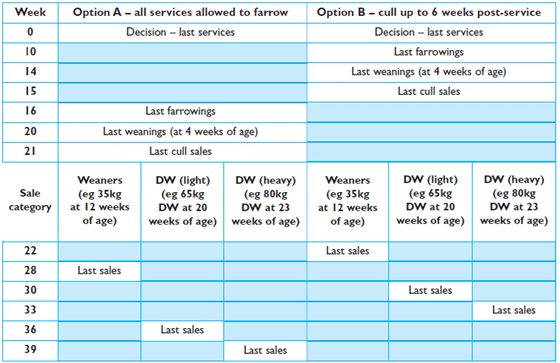



Strategic De-stocking
A guide for producers who, for financial or other reasons, are considering to cease pig production from BPEX in no. 42 in the 'Action for Productivity' series.Partial or complete de-population of a pig unit is often considered as a possible route to an improvement in health status, combined with strategic medication and/or re-population from a high-health source, i.e. often referred to as 'de-pop/re-pop'. That type of exercise has many options and can only be fully assessed on an individual unit basis, and is not within the scope of this factsheet, which is intended solely as outline guidance for producers who for financial or other reasons are contemplating the decision to cease production.
Targets
- To achieve strategic de-stocking in an organised way
- To optimise returns during the process
Depending on circumstances, it may be worth exploring the option of selling or renting the unit as a going concern, before commencing a de-stock.
Also, consider whether following the de-stock and clean-up, there may be opportunities for renting the facilities for pig production or converting buildings for alternative uses.
Staff Considerations
Staff should be informed and the timing of any redundancies or notice will need to be planned, and will depend on the timescale of events (see later) and the requirement for final cleaning operations.
Finishing Only
This is the simplest scenario, in that, subject to meeting any contractual obligations with the weaner supplier, the decision can be taken to not bring in any more pigs. See also later points on considerations of slaughter weight and final clean-down.
Breeding – All Types of Production
Stop serving
Once the decision to cease production has been made this is the start point of the de-stock, the timing of subsequent events will follow from that. Action points at this stage are:
- Cancel any regular order for semen and/or AI supplies
- Cancel any regular order for gilt replacements
- Cull any unserved sows and replacement gilts and then all sows as they are weaned.
Culling policy
Decide on whether to allow all served animals to farrow as normal or begin culling immediately, which will have implications for immediate cash-flow and the timing of subsequent production. The options are:
- Allow all served animals to farrow
- Cull all served animals up to six weeks in-pig. This will shorten the overall timescale and avoids any possible moral/ethical issues over the slaughter of heavily pregnant animals. It provides the optimum balance of cash-flow from sales and reduction of sow feed requirement
- Cull all served animals up to within two weeks of due date. Whilst this will give maximum immediate cashflow and reduction of sow feed requirement, this should only be considered in an emergency (ie if creditors are insisting on an immediate sale), as the slaughter of heavily pregnant animals has moral/ethical considerations. The transport regulations allow pregnant animals to be moved at “up to 90 per cent of the expected gestation length”, or two weeks away from farrowing in practical terms but this option should only be followed if absolutely necessary.
Points to consider:
- Discuss the sale of additional cull sows with your marketing group or outlet as advanced notice of exceptional numbers may be needed, and a better price can often be negotiated, eg for full lorry loads
- If there is a feed contract in place check any obligations, but at least notify the supplier that ordering patterns and overall requirements will be changing.
Weaner Production
If normal sale weight is 30–35kg then the best option is probably to continue as normal, although if circumstances dictate, it might be possible to explore the sale of pigs at weaning.
Points to Consider:
- Discuss the situation with your marketing group or purchaser
- If there is a contract in place check any obligations with regard to notice period.
Finisher Production
Depending on circumstances it may be necessary to consider selling weaners and/or reduce sale weight to shorten the overall time-scale and improve immediate cash-flow and reduction of feed costs.
Points to consider:
- Depending on market conditions at the time, spot prices for occasional sales of weaners can be unpredictable
- If there is a reasonable prediction of an increase in slaughter pig prices, then demand, and therefore price, for weaners may be good, but in that case the best option may be to finish the pigs anyway, if circumstances permit.
Table of various time-scales from decision point, i.e. cessation of serving

Actions After De-stocking
- Whatever the intended future use of the buildings and facilities, it is advisable to thoroughly clean and disinfect them and remove all manure and slurry. It will be possible to start doing this as sections of the unit become empty
- If the unit is permitted by the Environment Agency under the Environmental Permitting Regulations (EPR, formerly and more commonly known as IPPC), it will be necessary to surrender the permit and comply with the conditions specified in the site closure plan submitted with the original application. However, if there is scope for the unit to be sold or rented to another party, the permit is an asset and can be transferred to another operator.
July 2013








